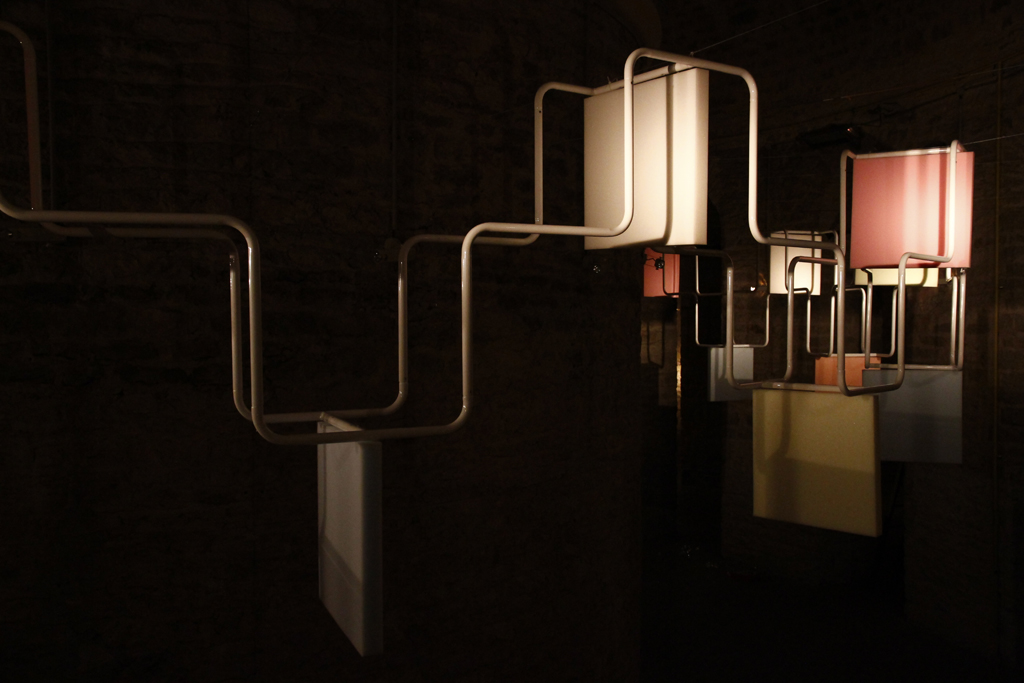

Catalyse
Célaine Poulain
The first time I saw Mario d’Souza’s work was during Bénédicte Ramade’s exhibition “Rehab”. I was incredibly intrigued by these abstract forms vaulted into chairs and their melancholic aestheticism. Surprisingly enough, the invitation to meet Mario d’Souza to talk about his work and discuss the installation he was to exhibit at the Château d’eau in Bourges arrived the following week. The piece, which the artist exhibits here, situates itself in the continuity of the work we have come to associate him with, but constitutes nonetheless a mutation from his practice due to the location’s dominating presence and the integration of the piece into this context.
The objects produced by Mario d´Souza have a history. The foam he uses for his sculptures is reclaimed — consisting in fragments discarded by the industrial sector, it bears the markings, the traces, the stigmata of its anterior use. To re-use, to give a material another finality, to offer it a new history to live through, is, curiously enough, what interests the artists in the forms he generates. First and foremost, it is the relationship to a material and its unexpected use that will guide production.
As with any other sculptor, the notion of balance and constraint, the tension of the assembled elements will give the gesture its thrust and give rise to the final shape the sculpture will take. But all of this formal undertaking is inhabited by a connection to the other. The chair, the essential component of the artist’s vocabulary, is of course a metonymic figure of the human body. The elements that are associated with it resonate, through their stiffness or their malleability, with this symbol of the quotidian to tend towards an image which always poses the question of the equilibrium of relations.
For the specific installation at the Château d’eau, Mario d´Souza had to work with a location that has a history, a location that bears its own stigmata. For the artist, a water castle is branded by its own rhizomatic character—by its very architecture, it is the bearer of the collective history it embodies. It was the central location for water distribution and the tower’s circular shape accentuated the image of the core, of the distribution center. Mario d´Souza associates the figure of the circle, very present in the artist’s work, to a global movement, the circle being the image of the infinite, of perpetual movement. This circularity is what Mario d´Souza´s installation literally brings to the foreground. The artist here considers the location to be a found material, in the image of the objects he uses and to which he will associate other elements in order to reveal them—from this place branded by an obsolete use, Mario d´Souza tries to render one of its forgotten aspects visible, that of catalyst. That is why, contrary to habit, the artist here employs the most standardized materials, smoother ones, the shape of which will mesh itself into the setting like a backbone. The installation emphasizes, accentuates and draws the existing. The choice of color, rather unusual, stems from the humanity which the artist perceives in this location— the interrelation evoked by the Château d’eau and its current status as an exhibition venue open to all, makes it the privileged space of encounter. The rapport of the eye to the color is one of immediate pleasure. For the artist, the use of color is a direct address to the spectator’s sensations.
The artist frequently uses the term “comfort” to talk about our relationship to the world. The definition of comfort is to settle into pleasing sensations. But as denounced by Nietzsche, physical comfort quickly lends itself to easy thoughts, to a form of mediocrity. If Mario d´Souza’s work seems to welcome the visitor, to suggest a pleasant experience, the artist’s objective is to problematize this apparent well-being and the satisfaction which stems from it. The perpetual questioning regarding the reception of his oeuvre, the interest in the usage of the space in which the work inscribes itself and which becomes its very material and the will to communicate his own questioning to the audience, all these parameters, when brought together, turn Mario d´Souza´s production into generous works that are in constant evolution.